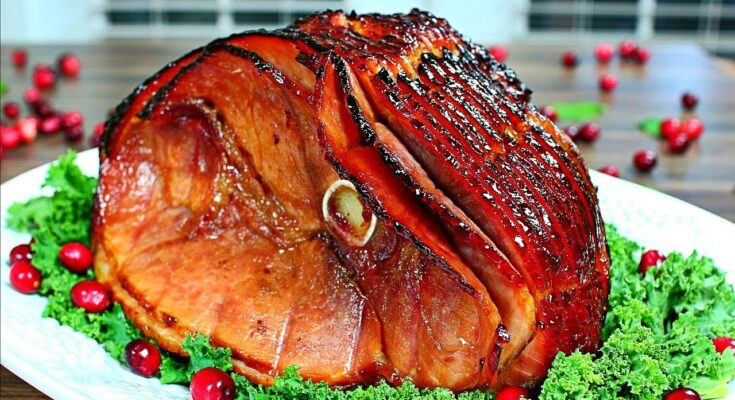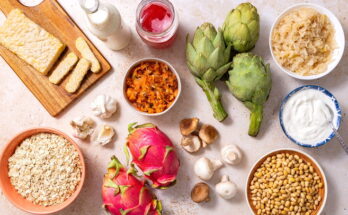Ham Glaze Recipe: When it comes to holiday feasts or special family dinners, a perfectly glazed ham often takes center stage. The glaze doesn’t just make the ham look mouthwateringly golden—it also elevates its flavor to new heights. With the right combination of sweetness, tang, and spice, your ham will become the star of the meal.
In this guide, we’ll take you step-by-step through creating the perfect ham glaze. Whether you’re a seasoned cook or a beginner in the kitchen, this recipe will help you achieve a tender, flavorful, and beautifully glazed ham every time.
Benefits of Using a Ham Glaze
Adds Flavor and Moisture
A ham glaze doesn’t just sit on the surface—it seeps into the meat, adding a rich layer of flavor and ensuring your ham stays moist during cooking.
Creates a Caramelized Crust
The sugars in the glaze caramelize as the ham bakes, forming a golden-brown crust that’s both visually appealing and deliciously crunchy.
Provides Versatility in Flavors
From sweet to savory and even spicy, the possibilities for ham glazes are endless. This allows you to customize your ham to suit your tastes or match a specific holiday theme.
Ingredients for the Perfect Ham Glaze
The key to a great ham glaze lies in balancing its flavors. Most recipes start with sweet ingredients, which are then enhanced with tangy or savory elements and finished with aromatic spices.
Sweet Ingredients for Glazes
- Honey: Adds a floral sweetness and stickiness for a glossy finish.
- Brown Sugar: A staple for its deep molasses flavor.
- Maple Syrup: Offers a natural, rich sweetness perfect for fall and winter.
Savory and Tangy Additions
- Mustard: Balances the sweetness with a touch of tang.
- Vinegar: Adds acidity to cut through the richness of the ham.
- Soy Sauce: Introduces a savory, umami flavor.
Spices and Aromatics
- Cinnamon and Cloves: Classic warm spices for a holiday feel.
- Garlic: For a savory depth that complements sweet flavors.
Choosing the Right Glaze for Your Ham
Not all hams are created equal, and choosing the right glaze can make a significant difference. Spiral-cut hams are great for sweet glazes, while bone-in hams pair well with robust, savory flavors. During the holidays, opt for festive ingredients like cranberry or orange zest for a seasonal twist.
Preparing Your Ham Before Glazing
Before you begin glazing, some prep work is essential:
- Score the Ham: Use a sharp knife to make shallow cuts in a crisscross pattern. This helps the glaze penetrate the meat and creates a visually appealing presentation.
- Remove Excess Moisture: Pat the ham dry with paper towels to help the glaze stick better.
- Set Up for Glazing: Place the ham on a roasting rack in a shallow pan to allow even cooking.
Step-by-Step Guide to Making Ham Glaze
Step 1: Gather Your Ingredients
Start by assembling everything you need. For a basic glaze, you’ll need:
- ½ cup honey or brown sugar
- 2 tablespoons Dijon mustard
- 1 tablespoon apple cider vinegar
- Optional spices: cinnamon, cloves, or ginger
Step 2: Mix the Ingredients
In a small saucepan, combine your ingredients over medium heat. Stir until the sugar dissolves and the mixture is smooth and slightly thickened. This process only takes a few minutes but is crucial for a perfectly balanced glaze.
Step 3: Apply the Glaze
Use a brush or spoon to apply the glaze evenly over the ham, ensuring you get into the scored lines. Reserve some glaze for basting later.
Step 4: Bake the Ham
Place the ham in a preheated oven (325°F/160°C). Baste it with the reserved glaze every 20 minutes to maintain a glossy finish. Cook until the internal temperature reaches 140°F (60°C).
Tips for the Perfect Ham Glaze
- Avoid Over-Glazing: Too much glaze can burn. Apply it in layers for the best results.
- Balance Flavors: Add a pinch of salt if your glaze is overly sweet.
- Don’t Skip Basting: This ensures an even, flavorful crust.
Common Mistakes to Avoid
Even with the best intentions, a few common mistakes can lead to a less-than-perfect ham. Avoid these pitfalls to ensure your dish turns out flawlessly:
Applying Glaze Too Early
While it may be tempting to glaze the ham right from the start, doing so can cause the sugars to burn. Always wait until the last 30-40 minutes of cooking to apply your glaze.
Using Too Much Glaze
A thick layer of glaze may drip off the ham and scorch in the pan. Apply the glaze in thin, even layers, basting periodically for the best results.
Skipping the Scoring Step
Scoring the ham not only helps the glaze penetrate the meat but also prevents the skin from shrinking during cooking.
Serving and Presentation
Once your ham is beautifully glazed and cooked to perfection, it’s time to present it. A few thoughtful touches can take your presentation to the next level:
Garnishing Ideas
- Add fresh herbs like rosemary or thyme for an elegant touch.
- Arrange slices of orange, pineapple, or apples around the ham for a festive look.
- Sprinkle pomegranate seeds for a pop of color and texture.
Pairing Suggestions
Glazed ham pairs wonderfully with a variety of side dishes. Some popular options include:
- Mashed potatoes or sweet potato casserole.
- Roasted vegetables like carrots, Brussels sprouts, or green beans.
- A tangy cranberry or apple chutney to complement the ham’s sweetness.
Storing and Reheating Glazed Ham
A glazed ham often leaves plenty of leftovers, and storing it properly ensures you can enjoy it for days to come.
Best Practices for Storage
- Allow the ham to cool completely before refrigerating.
- Wrap it tightly in aluminum foil or plastic wrap to retain moisture.
- Store in the fridge for up to five days or freeze for longer storage (up to three months).
Reheating Tips
- Preheat your oven to 275°F (135°C).
- Place the ham in a baking dish, add a splash of water or broth, and cover tightly with foil.
- Heat until warmed through, typically 10-15 minutes per pound. Avoid overheating, as this can dry out the meat.
Popular Ham Glaze Variations
Glazing a ham allows for endless creativity. Here are three tried-and-true variations to inspire your next feast:
Classic Honey-Mustard Glaze
- Ingredients: Honey, Dijon mustard, brown sugar, apple cider vinegar.
- Flavor Profile: A perfect balance of sweet and tangy with a hint of sharpness from the mustard.
- Best For: Traditional dinners or Easter celebrations.
Sweet and Spicy Brown Sugar Glaze
- Ingredients: Brown sugar, cayenne pepper, paprika, orange juice.
- Flavor Profile: Sweet with a spicy kick that pairs wonderfully with smoky hams.
- Best For: Barbecues or holiday gatherings with a twist.
Tropical Pineapple Glaze
- Ingredients: Pineapple juice, brown sugar, soy sauce, ginger.
- Flavor Profile: Sweet, fruity, and slightly tangy, evoking tropical vibes.
- Best For: Summer dinners or Hawaiian-themed celebrations.
FAQs about Ham Glaze Recipe
1. Can I glaze a pre-cooked ham?
Absolutely! In fact, pre-cooked hams are often the best candidates for glazing. Simply follow the same glazing and baking instructions, but heat the ham to an internal temperature of 140°F (60°C).
2. How do I prevent my glaze from burning?
Apply the glaze during the last 30-40 minutes of cooking and baste frequently. This ensures the sugars caramelize without burning.
3. Can I use leftover glaze as a sauce?
Yes, but ensure it’s heated thoroughly to kill any bacteria, especially if it came into contact with raw meat.
4. What’s the best type of ham for glazing?
Bone-in spiral hams are ideal, as they hold moisture well and provide a surface for the glaze to stick. Boneless hams also work but may require more attention to prevent drying out.
5. Can I make the glaze ahead of time?
Yes! Prepare the glaze up to three days in advance and store it in an airtight container in the refrigerator. Warm it slightly before applying to the ham.
Conclusion
A perfectly glazed ham can transform any meal into a celebration. From choosing the right ingredients to mastering the glazing process, this step-by-step guide ensures you’ll create a dish that’s both visually stunning and irresistibly delicious. Whether you’re hosting a holiday feast or preparing a family dinner, your ham will undoubtedly steal the show.



